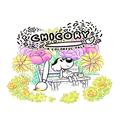When you look at the description for Chicory: A Colorful Tale on Steam, you'll notice that the developer describes the experience as The Legend of Zelda with a dash of Animal Crossing. That alone sounds interesting enough for anyone to want to give the demo a shot, but you'll quickly discover that the game takes inspiration from many other titles to create something unique but familiar and inviting.
The premise is whimsical enough. You live in a world that is completely black and white, and color is added with a magical paintbrush. Throughout the generations, special people have been given the designation of wielder and been tasked with adding colors to the world as they saw fit. The current wielder, a bunny named Chicory, has a host of admirers. You're one of them, a dog who is the self-proclaimed biggest fan; you're cleaning your abode one day when a mysterious event occurs. The color in the world has vanished, the magical paintbrush has been left on the floor, and Chicory has disappeared. Without a clue about Chicory's whereabouts, you pick up the paintbrush and try to be a temporary wielder until she can be found.
It doesn't take long to see why the comparisons to The Legend of Zelda and Animal Crossing would come up. For the former, you're looking at everything from a top-down perspective, and the area is segmented into single screens that shift once you reach the edges. For the latter, every person you encounter is an animal, and most of them usually ask a favor of you. It also helps that most of the rewards you get for completing tasks or for opening treasure chests are articles of clothing, so there is some impetus to do everything you can to customize your pooch.
Chicory also seems to take inspiration from a few other titles. The black-and-white world can be compared to Hidden Folks or West of Loathing, since the world is in stark white while everything else it outlined in black, like a coloring book. The idea of coloring your world will feel familiar to those who have played either of the de Blob games, and the use of a paintbrush feels similar to the marker used in Max and the Magic Marker, as that is your primary means of manipulating the world.
That world manipulation is put to good use, as the majority of the demo is spent using the brush to solve puzzles. Tapping on a few objects several times, for example, will coax out kittens that need to be brought back to their house for a nap. Painting in trees can make them shrink, and erasing the paint can make them grow, a technique you'll use often to create new pathways at higher elevations. The same technique also works for mushrooms, which act as springboards to launch you over large gaps. The demo never had anything that could be considered highly difficult, but the puzzles remained enjoyable nonetheless.
One of the more striking things is that Chicory is a mostly non-violent game. Not once did we see a stray enemy, and the concept of traps and pitfalls is completely absent. There isn't even a health meter to worry about or pick-ups that indicate you're recovering from getting hurt. The only time you ever saw any combat was during the demo's only boss fight, and even then, you never died no matter how many times you got hit, and your method of fighting back is to simply paint the boss several times. This is an interesting approach to the title, and we're curious to see if it remains true from the beginning to the end of the game.
Like quite a number of games featured during The Game Awards, there's no solid release date for Chicory: A Colorful Tale. It just had a successful Kickstarter, so that's a good sign, but with the store page listing a date of 202X, we have no idea when we'll see the game next. With that said, the demo does a good job of making a good first impression, and we can't wait to check out a future build to see how things are progressing.
More articles about Chicory: A Colorful Tale










 In Chicory: A Colorful Tale you're a dog wielding a magic brush. Use painting powers to explore, solve puzzles, and make friends in this top-town adventure game.
In Chicory: A Colorful Tale you're a dog wielding a magic brush. Use painting powers to explore, solve puzzles, and make friends in this top-town adventure game.




